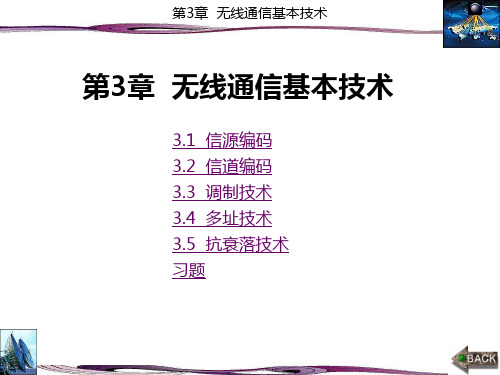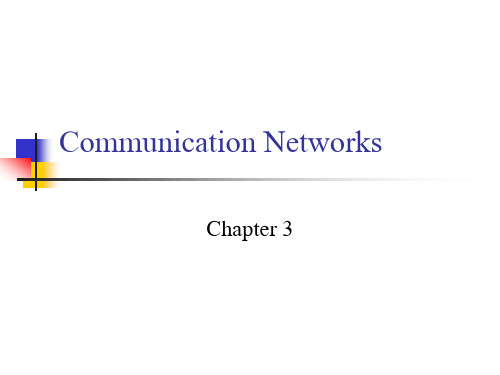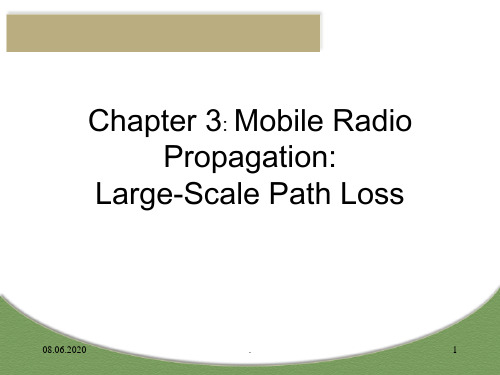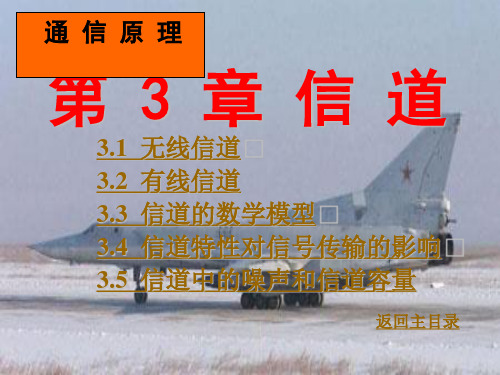无线通信原理与应用第三章PPT课件
合集下载
无线通信基本原理PPT课件

室内非视距
4~6
16
无线传播环境-传播损耗
25 dB/dec
30 dB/dec
20 dB/dec
40 ..50 dB/dec
path loss
17
无线传播环境-传播损耗
电波传播受地形结构和人为环境的影响,无线传播 环境直接决定无线传播方式。影响无线电波传播方式 的主要因素有:
• 自然地形(高山、丘陵、平原、水域) • 人工建筑的数量、分布、材料特性 • 植被特征 • 天气状况
无线通信基本原理
1.无线电波传播的基础理论 2.移动通信基本原理
1
1.无线电波传播的基础理论
2
无线传播基本原理-电波传播方式:
• Free- space propagation
Signal strength decreases exponentially with distance
D
• Reflection
• 在分配成语音信道后,基站和移动台就会同时地连续不断地发射 • FDMA通常是窄带系统,TACS为代表,每信道25kHz带宽 • FDMA比TDMA简单,同步和组帧比特少,系统开销小
• FDMA需要精确的RF滤波器,需要双工器(单天线)
• 非线性效应:许多信道共享一个天线,功率放大器的非线性会产生交 调频率(IM),产生额外的RF辐射
• 在典型的蜂窝移动通信环境中,移动台一般比基站天 线矮很多,接收机与发射机之间的直达路径往往被建 筑物或其他物体所阻碍。所以,在蜂窝基站与移动台 之间的通信不一定是通过直达路径,而是通过许多其 他路径完成的。
7
无线传播基本原理-传播途径(多径)
发射信号
接收信号 强度
时间 8
无线传播环境-信号衰落
无线通信.ppt

第3章 无线通信基本技术
解:
系统可用的语音信道的带宽=0.9×(826-810)=
Hale Waihona Puke 14.4 MHz,用户数=1150
最大的语音信道带宽=
14.4 MHz 1150 ≈12.5 kHz
频谱效率=1.68 (b/s)/Hz
最大的信道数据率=1.68×12 500 b/s=21 kb/s FEC编码比率=0.5
第3章 无线通信基本技术
表3-1 用于各种移动通信系统的语音编码方式
第3章 无线通信基本技术
例3-1 某一个数字移动通信系统,其前向信道频率带宽 为810~826 MHz,反向信道频率带宽为940~956 MHz。假设 90%的带宽用于语音业务,用FDMA多址接入方式,至少支 持1150个同时呼叫,调制方案的频谱效率为1.68 (b/s)/Hz, 为避免信道恶化产生的误码率,需要用比率为1/2的FEC前 向纠错编码。请求出用于该系统的语音编码器传输比特率的 上限。
(5) 子带(subband)编码。
该法是将数据变换到频域后,按频域分带,然后用不同的量化器进 行量化,从而达到最优的组合;或者分步渐近编码,在初始时,对某一 频带的信号进行解码,然后逐渐扩展到所有频带。随着解码数据的增加, 解码数据也逐渐变得清晰。
第3章 无线通信基本技术
(6) 模型编码。
该法是在图像编码中,编码时首先将图像中的边界、轮廓、纹理 等结构特征找出来,然后保存这些参数信息,解码时根据结构和参数信 息进行合成,恢复原始图像。具体的模型编码方法有轮廓编码、域分割 编码、分析合成编码、识别合成编码、基于知识的编码和分形编码等。
第3章 无线通信基本技术
美国TDMA蜂窝系统(IS-54)运用8 kb/s的VSELP语音 编解码器,将模拟系统(AMPS)的容量提高了3倍。 CDMA蜂窝系统(IS-95)中所采用的是CELP(码激励线性 预测编码)方式。由于CDMA系统内部具有抗干扰能力和扩 展带宽的能力,所以可以运用低比特率语音编解码器,而无 需考虑对于传输误差的影响。表3-1给出的是部分移动通信 系统中所采用的语音编码类型和它所输出的数据比特率。
通信原理-信道-PPT课件

4
•编码信道模型: 二进制信号、无记忆信道,
0 P(0/1) 1 P(1/1)
P(0/0)
P(1/0)
0 1
其中,P(0/0), P(1/1) - 正确转移概率 P(0/1), P(1/0) - 错误转移概率 转移概率 - 决定于编码信道的特性 P(0/0) = 1 - P(1/0) P(1/1) = 1 - P(0/1)
13
通信卫 星
电离层
地—电离层 波导传 播
电离层
天波传 播
地球
地球 外大气 层及行星 际空间 电波传播
视距传 播 对流层 散射传播 电离层 散射传播 (b)
(a)
14
无线电中继
图1.4.4 无线电中继
15
静止卫星中继通信
16
平流层中继通信
HAPS(High
Altitude Platform Station)
11
(5)散射传播。 这是利用对流层或电离层介质中的不均匀体或流 星余迹对无线电波的散射作用而进行的传播。利用散 射传播实现通信的方式目前主要是对流层散射通信, 其常用频段为 0.2 ~ 5MHz ,单跳距离可达 100 ~ 500km 。 电离层散射通信只能工作在较低频段 30~60MHz, 单跳距离可达1000~2000km,但因传输频带窄,其应 用受到限制。 流星余迹持续时间短,但出现频繁,可用于建立 瞬间通信,常用通信频段为 30~70MHz,单跳通信可 达2000km。实际的流星余迹通信除了利用散射传播外, 还可利用反射进行传播。
3
通常, f [ei(t) ] 可以表示为:k(t) ei(t), 此时, eo(t) = k(t) ei(t) + n(t) 其中k(t)表示时变线性网络的特性 ,称为乘性干扰。
•编码信道模型: 二进制信号、无记忆信道,
0 P(0/1) 1 P(1/1)
P(0/0)
P(1/0)
0 1
其中,P(0/0), P(1/1) - 正确转移概率 P(0/1), P(1/0) - 错误转移概率 转移概率 - 决定于编码信道的特性 P(0/0) = 1 - P(1/0) P(1/1) = 1 - P(0/1)
13
通信卫 星
电离层
地—电离层 波导传 播
电离层
天波传 播
地球
地球 外大气 层及行星 际空间 电波传播
视距传 播 对流层 散射传播 电离层 散射传播 (b)
(a)
14
无线电中继
图1.4.4 无线电中继
15
静止卫星中继通信
16
平流层中继通信
HAPS(High
Altitude Platform Station)
11
(5)散射传播。 这是利用对流层或电离层介质中的不均匀体或流 星余迹对无线电波的散射作用而进行的传播。利用散 射传播实现通信的方式目前主要是对流层散射通信, 其常用频段为 0.2 ~ 5MHz ,单跳距离可达 100 ~ 500km 。 电离层散射通信只能工作在较低频段 30~60MHz, 单跳距离可达1000~2000km,但因传输频带窄,其应 用受到限制。 流星余迹持续时间短,但出现频繁,可用于建立 瞬间通信,常用通信频段为 30~70MHz,单跳通信可 达2000km。实际的流星余迹通信除了利用散射传播外, 还可利用反射进行传播。
3
通常, f [ei(t) ] 可以表示为:k(t) ei(t), 此时, eo(t) = k(t) ei(t) + n(t) 其中k(t)表示时变线性网络的特性 ,称为乘性干扰。
无线通信基础PPT课件PPT47页

1.3.2 语音编码(信源编码)
第 35
页
语音编码的基本方法:波形编码和参量编码
混合编码: 在混合编码的信号中,既含有若干语音特征参量信息又
含有部分波形编码信息。
规则脉冲激励线性预测编码(RPE-LPC)、矢量和激 励线性预测编码(VSELP)等属于混合编码。在数字移 动通信中得到了广泛应用。
X 第36页,共47页。
X 第25页,共47页。
1.3.1 基本概念
第 25
页
1、通信系统与通信网
(2)数字通信系统
数字调制和解调:数字调制把数字基带信号的频谱从低
频搬到高频,形成适合在信道中传输的频带信号。数字解 调是在接收端恢复数字基带信号。
同步与数字复接:同步使收、发两端的信号在时间上保持
步调一致。数字复接是依据时分复用基本原理把若干个 低速数字信号合并成一个高速的数字信号,以扩大传输 容量,提高传输效率。
式中, ma=Um为U调cm幅度
X 第16页,共47页。
1.2.1 幅度调制
第 16
页
1、双边带调幅(AM)
Ucm
1/2ma Ucm
1/2ma Ucm
c
c c
(c)
单音调制的双边带调幅波(AM)的波形与频谱
X 第17页,共47页。
1.2.1 幅度调制
第 17
页
2、单边带调制(SSB)
(a)话音信号频谱
X 第26页,共47页。
1.3.1 基本概念
第 26
页
1、通信系统与通信网
(3)通信网
双向、多点通信
X 第27页,共47页。
1.3.1 基本概念
第 27
页
2、信息速率、信噪比、误码率与信道容量
《无线通信原理总结》PPT课件

前向信道应用: 1)利用短码PN标识不同的扇区:短码PN的长度为
215=32768chip,不同扇区导频的PN偏置不同,使用导频号Pilot Number来标识不同的PN偏置:0~511,相邻的两个导频号之间 相差64个码片。终端中的搜索器完成PN码的捕获和跟踪。 2)利用长码PN来扰码
反向信道应用: 1)利用短码PN来扩频:正交调制,PN的偏置为0 2)利用长码PN来区分不同的用户
(2)视距传播极限
d4 .12 h th r
三 移动信道的传播特性
4、障碍物的影响
(1)菲涅尔余隙的概念
(2)障碍物影响下的路径传波损耗的计算 P97 例3-1
三 移动信道的传播特性
5、移动信道特征
(1)慢衰落↔衰落储备
(2)快衰落:
多径效应→瑞利衰落(包络)、平均分布(相位)
多径时散↔相关带宽 多普勒扩散↔相干时间
4、工作频率 824-849MHz 869-894MHz 5、时间基准 移动台 基站 6、话音编码 CELP(中英文全称)
七 IS-95系统 CDMA
7、CDMA蜂窝通信系统的通信容量
n W/ Rb GF Eb / I0 d
影响因子:G、F、d含义
七 IS-95系统 CDMA
8、无线传输 信道组成:
Байду номын сангаас
七 IS-95系统 CDMA
1、码分多址蜂窝通信系统特征 容量大 软容量 软切换 话音激活 具有扩频的优点 2、码分多址与扩频的结合
七 IS-95系统 CDMA
3、多址干扰和功率控制
多址干扰
远近效应
功率控制
◦ 目的 ◦ 方法:
正向
开环
反向
闭环
◦ 原则
215=32768chip,不同扇区导频的PN偏置不同,使用导频号Pilot Number来标识不同的PN偏置:0~511,相邻的两个导频号之间 相差64个码片。终端中的搜索器完成PN码的捕获和跟踪。 2)利用长码PN来扰码
反向信道应用: 1)利用短码PN来扩频:正交调制,PN的偏置为0 2)利用长码PN来区分不同的用户
(2)视距传播极限
d4 .12 h th r
三 移动信道的传播特性
4、障碍物的影响
(1)菲涅尔余隙的概念
(2)障碍物影响下的路径传波损耗的计算 P97 例3-1
三 移动信道的传播特性
5、移动信道特征
(1)慢衰落↔衰落储备
(2)快衰落:
多径效应→瑞利衰落(包络)、平均分布(相位)
多径时散↔相关带宽 多普勒扩散↔相干时间
4、工作频率 824-849MHz 869-894MHz 5、时间基准 移动台 基站 6、话音编码 CELP(中英文全称)
七 IS-95系统 CDMA
7、CDMA蜂窝通信系统的通信容量
n W/ Rb GF Eb / I0 d
影响因子:G、F、d含义
七 IS-95系统 CDMA
8、无线传输 信道组成:
Байду номын сангаас
七 IS-95系统 CDMA
1、码分多址蜂窝通信系统特征 容量大 软容量 软切换 话音激活 具有扩频的优点 2、码分多址与扩频的结合
七 IS-95系统 CDMA
3、多址干扰和功率控制
多址干扰
远近效应
功率控制
◦ 目的 ◦ 方法:
正向
开环
反向
闭环
◦ 原则
无线通信技术原理 ppt课件

2020/12/2 广州公司 网络优化中心
第6页
6 正 德 厚 生、臻 于 至 善
移动通信的特点
➢ 移动通信必须利用无线电波进行信息传 输;
➢ 电波传播特性复杂; ➢ 干扰多而复杂; ➢ 组网方式多样灵活; ➢ 移动通信设备必须适于在移动环境中使
用,对手机的主要要求是体积小、重量 轻、省电、操作简单携带方便。
无线通信技术原理
2007年12月2日
2020/12/2 广州公司 网络优化中心
第1页
1 正 德 厚 生、臻 于 至 善
• 移动通信系统概述 • 移动通信的组网技术原理 • 移动通信基本概念
2020/12/2 广州公司 网络优化中心
第2页
2 正 德 厚 生、臻 于 至 善
精品资料
• 你怎么称呼老师?
断作得大些,这样一个隔断可容纳几对交谈者。但大家交谈有一个原则:只能 同时有一对人讲话。如果再把交谈的时间按交谈者的数目分成若干等分,就成 为一个TDMA(时分多址)系统。这种系统受容量的限制很大,即一个隔断中有 几个人是确定的,如果人数已满,则无法进入。
CDMA数字通信系统:采用CDMA(码分多址)技术。可以想象一个宽
2020/12/2 广州公司 网络优化中心
第9页
9 正 德 厚 生、臻 于 至 善
移动通信系统概论
通信系统网络的分类
通信网
核心网 接入网
2020/12/2 广州公司 网络优化中心
有线接入 无线接入
第 10 页
光纤接入: PON、APON
FTTB/C/H/R
混合光纤同轴网 Cable Modem DSL(ADSL、HDSL)
2020/12/2 广州公司 网络优化中心
无线通信原理与应用-3.5 提高蜂窝系统容量

常用天线下倾,即将基站的辐射能量集中指向地面(而不是水平方向),来限 制新构成的微小区的无线覆盖。
电气工程学院 通信工程系
无线通信原理与应用
Wireless Communications Principles and Practice
例题
•见右图。假设不管小区大小,每个基站都 使用60个信道。如果原来的小区每个半径 为lkm,每个微小区的半径为0.5km,计算 以A为中心的3km×3km的正方形区域所含 有的信道数。 •(a)不使用微小区, •(b)用了图2.9中标有字母的微小区, •(c)原来 的所有基站都用微小区来代替。
1. 小区分裂:通过增加基站的数量来增加系统容量;不降低中继效率,使得基站能监 视与微小区有关的所有切换,从而减小MSC的计算量
2. 裂向(划分扇区):用有方向的天线来进一步控制干扰和信道的频率复用;依靠基 站天线的定位来减小同频干扰以提高系统容量;降低了中继效率;
3. 覆盖区域逼近(分区微小区):微小区概念将小区覆盖分散,将小区边界延伸到难 以到达的地方;依靠基站天线的定位来减小同频干扰以提高系统容量;不降低中继
小区分裂应用中需要注意的问题
注意点1:不是所有的小区都同时分裂。对于服务提供 者来说,要找到完全适合小区分裂的确切时期通常很困 难。因此,不同规模的小区将同时存在。
注意点2:保持同频小区间所需的最小距离,因而频率 分配变得更复杂。
电气工程学院 通信工程系
无线通信原理与应用
Wireless Communications Principles and Practice
因而能提高系统容量。
II. 通过设定比原小区半径更小的新小区和在原有小区间安置这些小区(叫 做微小区),使得单位面积内的信道数目增加,从而增加系统容量。
电气工程学院 通信工程系
无线通信原理与应用
Wireless Communications Principles and Practice
例题
•见右图。假设不管小区大小,每个基站都 使用60个信道。如果原来的小区每个半径 为lkm,每个微小区的半径为0.5km,计算 以A为中心的3km×3km的正方形区域所含 有的信道数。 •(a)不使用微小区, •(b)用了图2.9中标有字母的微小区, •(c)原来 的所有基站都用微小区来代替。
1. 小区分裂:通过增加基站的数量来增加系统容量;不降低中继效率,使得基站能监 视与微小区有关的所有切换,从而减小MSC的计算量
2. 裂向(划分扇区):用有方向的天线来进一步控制干扰和信道的频率复用;依靠基 站天线的定位来减小同频干扰以提高系统容量;降低了中继效率;
3. 覆盖区域逼近(分区微小区):微小区概念将小区覆盖分散,将小区边界延伸到难 以到达的地方;依靠基站天线的定位来减小同频干扰以提高系统容量;不降低中继
小区分裂应用中需要注意的问题
注意点1:不是所有的小区都同时分裂。对于服务提供 者来说,要找到完全适合小区分裂的确切时期通常很困 难。因此,不同规模的小区将同时存在。
注意点2:保持同频小区间所需的最小距离,因而频率 分配变得更复杂。
电气工程学院 通信工程系
无线通信原理与应用
Wireless Communications Principles and Practice
因而能提高系统容量。
II. 通过设定比原小区半径更小的新小区和在原有小区间安置这些小区(叫 做微小区),使得单位面积内的信道数目增加,从而增加系统容量。
最新第3讲-无线通信系统.课件ppt

通信。
24
物联网概论
➢ 时分多址(TDMA)访问技术
第3讲 无线通信系统
• 时分多址(Time Division Multiple Access,TDMA)是把时间分割成周 期性帧(Frame),每一个帧再分割成若干个时隙向基站发送信号, 在满足定时和同步的条件下,基站可以分别在各时隙中接收到各 移动终端的信号而不混扰。基站发向多个移动终端的信号都按顺 序安排在预定的时隙中传输,各移动终端只要在指定的时隙内接 收,就能在合路的信号中把发给它的信号区分并接收下来。
• 跳频通信的关键技术是如何实现接收和发送端在改变频道过程 中实现频道的一致同步,且在跳频过程中应当尽可能的少花费 时间。
• FHSS和FDMA一样是一个多频率的通信方式。
29
课后作业
物联网概论
3-3,3-7,3-8
第3讲 无线通信系统
补:什么是扩频通信技 术?
30
新材料作文审题训练
• 文题一: 阅读下面文字,按要求作文。
物联网概论
第3讲 无线通信系统
3.4.2 有效性指标-----频带利用率
频带利用率η是描述数据传输速率和带宽之间关系的1 个指标。它是单位时间内所能传 输的信息速率,可表示为 系统的传输速率/系统的頻带宽度(B),单位为Bd/HZ或 bit/(s .Hz)
η=NBd/B η=R/B
从以上可看出,若码元速率相同,加大M或减少B都可使頻带 利用率提高。前者可采用 多进制调制技术实现,后者可采 用单边调制、部分响应等压缩发送信号频谱的方法。
• 在FDMA系统中,分配给用户一个信道,
即一对频谱,一个频谱用作前向信道
即基站向移动台方向的信道,另一个
则用作反向信道即移动台向基站方向
无线通信原理与应用-第三章 网络技术基础

High-speed local area network (LAN) Metropolitan area network (MAN) High-speed wide area network (WAN)
Higher-speed
Speed and Distance of Communications Networks
LAN interconnects devices within a single building or cluster of buildings
LAN usually owned by organization that owns the attached devices
For WANs, most of network assets are not owned by same organization
Characteristics of WANs
Covers large geographical areas Circuits provided by a common carrier Consists of interconnected switching nodes Traditional WANs provide modest capacity
Circuit switching
Dedicated communications path between two stations E.g., public telephone network
Message is broken into a series of packets Each node determines next leg of transmission for each packet
Higher-speed
Speed and Distance of Communications Networks
LAN interconnects devices within a single building or cluster of buildings
LAN usually owned by organization that owns the attached devices
For WANs, most of network assets are not owned by same organization
Characteristics of WANs
Covers large geographical areas Circuits provided by a common carrier Consists of interconnected switching nodes Traditional WANs provide modest capacity
Circuit switching
Dedicated communications path between two stations E.g., public telephone network
Message is broken into a series of packets Each node determines next leg of transmission for each packet
无线通信原理与应用第三章

08.06.2020
.
8
The far-field region of a transmitting antenna
• The Friis free space model is only a valid predictor for Pr for values of d, which are in the far-field of the transmitting antenna.
received power.
• The path loss for the free space model when antenna gains are
included is given by quantity measured in dB, is defined as the
P(d L)B 1l0oP P r tg1l0o(G 4 g tG )[r 2 d22]
08.06.2020
.
6
9dBi antenna & 3dBi antenna
08.06.2020
.he path loss, which represents signal attenuation as a positive difference (in dB) between the effective transmitted power and the
and receiver is obstructed by a surface that has sharp irregularities (edges).
Scattering:occurs when the medium through which the wave travels consists of objects with dimensions that are small compared to the wavelength, and where the number of obstacles per unit volume is large.
通信原理第3章信道

增大视线传播距离的其他途径 ➢ 中继通信: ➢ 卫星通信:静止卫星、 移动卫星
图3.1-5 无线电中继
➢ 平流层通信:利用位于平流层的高空平台电台代替卫星作为 基站的通信。
11
第3章 信 道
三、电离层和大气层对于传播的影响
电离层对于传播的影响
反射 散射
大气层对于传播的影响
散射 吸收
衰 减
根据应用情况不同,在光纤线路中可能设有中继器 (也可不设)。中继器有两种类型:直接中继器和间接中继器。 所谓直接中继器就是光放大器,它直接将光信号放大以补偿光 纤的传输损耗,以便延长传输距离;所谓间接中继器就是将光 信号先解调为电信号,经放大或再生处理后,再调制到光载波 上,利用光纤继续进行传输。在数字光纤信道中,为了减少失 真及防止噪声的积累,每隔一定距离需要加入再生中继器。
电离层
电离层:约60 ~ 400 km
平流层
60 km
对流层
10 km
地面
0 km
6
第3章 信 道
3.短波电离层的传播路径
短波电离层反射信道是利用地面发射的无线电波在电 离层, 或电离层与地面之间的一次反射或多次反射所形成 的信道。
离地面60~400 km的大气层称为电离层。
电离层由分子、原子、离子及自由电子组成,形成的 原因是由于太阳辐射的紫外线和X射线。 当频率范围为 3~30 MHz (波长为10-100m)的短波(或称为高频)无线电 波射入电离层时, 由于折射现象会使电波发生反射,返回 地面,从而形成短波电离层反射信道。
制 器
光
光
纤
探
线测
路
器
基
基
带
带
处 理
电 信 号
图3.1-5 无线电中继
➢ 平流层通信:利用位于平流层的高空平台电台代替卫星作为 基站的通信。
11
第3章 信 道
三、电离层和大气层对于传播的影响
电离层对于传播的影响
反射 散射
大气层对于传播的影响
散射 吸收
衰 减
根据应用情况不同,在光纤线路中可能设有中继器 (也可不设)。中继器有两种类型:直接中继器和间接中继器。 所谓直接中继器就是光放大器,它直接将光信号放大以补偿光 纤的传输损耗,以便延长传输距离;所谓间接中继器就是将光 信号先解调为电信号,经放大或再生处理后,再调制到光载波 上,利用光纤继续进行传输。在数字光纤信道中,为了减少失 真及防止噪声的积累,每隔一定距离需要加入再生中继器。
电离层
电离层:约60 ~ 400 km
平流层
60 km
对流层
10 km
地面
0 km
6
第3章 信 道
3.短波电离层的传播路径
短波电离层反射信道是利用地面发射的无线电波在电 离层, 或电离层与地面之间的一次反射或多次反射所形成 的信道。
离地面60~400 km的大气层称为电离层。
电离层由分子、原子、离子及自由电子组成,形成的 原因是由于太阳辐射的紫外线和X射线。 当频率范围为 3~30 MHz (波长为10-100m)的短波(或称为高频)无线电 波射入电离层时, 由于折射现象会使电波发生反射,返回 地面,从而形成短波电离层反射信道。
制 器
光
光
纤
探
线测
路
器
基
基
带
带
处 理
电 信 号
《5G移动通信系统及关键技术》第03章 5G无线技术3.2-3.3

1-9
3.2.1 灵活双工技术
载波聚合(Carrier Aggregation,CA)——将多个不同频率(或者相同) 的载波聚合成一个更宽的频谱,同时也可以把一些不连续的 频谱碎片聚合到一起,从而达到提高带宽的效果 载波聚合、非载波聚合都可以采用灵活双工技术。 载波聚合应用场景中,网络可将原用于上行传输的频带用于 下行传输,并将该频带配置成辅载波辅小区; 非载波聚合应用场景中,网络可将原用于上行传输的频带用 于下行传输,并将该频带和上行频带配置成配对的频带。
1-17
3.2.2 同频同时双工
双工干扰分两类:
➢ 发射天线到接收天线的直达波 ➢ 经过多物体反射的多径到达波
全双工技术包括两方面:
➢ 全双工系统的自干扰抑制技术 ➢ 组网技术
双工干扰消除越多,系统频谱效率增益越大, 双工干扰被完全消除,则系统容量提升1倍。
1-18
3.2.2 同频同时双工
3、同时同频全双工中的干扰消除技术
简单,用户间干扰较小,但是受传输中信道衰落的影响比较 大。 – 间隔扩展子载波(Comb Spread Subcarriers),其特点是 通过频域扩展,增加频率分集,从而减少了信道衰落的影响。
多载波技术
(a) 分组子载波方式 (b) 间隔扩展thogonal Frequency Division Multiplexing)技 术是主流无线通信所采用的信号形式
Duplex,CCFD ——通信双方能够使用相同的时间、相同的频 率,同时发射和接收无线信号,从而将频谱效 率翻倍。 同频同时全双工的关键在于干扰的有效消除。
1-16
3.2.2 同频同时双工
2、同频同时全双工节点
节点基带信号经射频调制,从发射天线发出,而接收天线正在 接收来自期望信源的通信信号。
3.2.1 灵活双工技术
载波聚合(Carrier Aggregation,CA)——将多个不同频率(或者相同) 的载波聚合成一个更宽的频谱,同时也可以把一些不连续的 频谱碎片聚合到一起,从而达到提高带宽的效果 载波聚合、非载波聚合都可以采用灵活双工技术。 载波聚合应用场景中,网络可将原用于上行传输的频带用于 下行传输,并将该频带配置成辅载波辅小区; 非载波聚合应用场景中,网络可将原用于上行传输的频带用 于下行传输,并将该频带和上行频带配置成配对的频带。
1-17
3.2.2 同频同时双工
双工干扰分两类:
➢ 发射天线到接收天线的直达波 ➢ 经过多物体反射的多径到达波
全双工技术包括两方面:
➢ 全双工系统的自干扰抑制技术 ➢ 组网技术
双工干扰消除越多,系统频谱效率增益越大, 双工干扰被完全消除,则系统容量提升1倍。
1-18
3.2.2 同频同时双工
3、同时同频全双工中的干扰消除技术
简单,用户间干扰较小,但是受传输中信道衰落的影响比较 大。 – 间隔扩展子载波(Comb Spread Subcarriers),其特点是 通过频域扩展,增加频率分集,从而减少了信道衰落的影响。
多载波技术
(a) 分组子载波方式 (b) 间隔扩展thogonal Frequency Division Multiplexing)技 术是主流无线通信所采用的信号形式
Duplex,CCFD ——通信双方能够使用相同的时间、相同的频 率,同时发射和接收无线信号,从而将频谱效 率翻倍。 同频同时全双工的关键在于干扰的有效消除。
1-16
3.2.2 同频同时双工
2、同频同时全双工节点
节点基带信号经射频调制,从发射天线发出,而接收天线正在 接收来自期望信源的通信信号。
- 1、下载文档前请自行甄别文档内容的完整性,平台不提供额外的编辑、内容补充、找答案等附加服务。
- 2、"仅部分预览"的文档,不可在线预览部分如存在完整性等问题,可反馈申请退款(可完整预览的文档不适用该条件!)。
- 3、如文档侵犯您的权益,请联系客服反馈,我们会尽快为您处理(人工客服工作时间:9:00-18:30)。
• When antenna gains are excluded, the antennas are assumed to have
unity gain, and path loss is given by
PL(dB)10logP t 10log[ 2 ]
P r
(4)2d2
P L ( d B ) 3 2 .4 4 2 0 l g f 2 0 l g d(f:MHz,d:km)
08.05.2020
.
6
9dBi antenna & 3dBi antenna
08.05.2020
.
7
Path Loss
• The path loss, which represents signal attenuation as a positive difference (in dB) between the effective transmitted power and the
08.05.2020
.
4
• reflection(反射)at large obstacles, • Scates, • diffraction (衍射)at edges
08.05.2020
.
5
EIRP&ERP
2.15dB
EIRPPtGt
• EIRP: Effective Isotropic Radiated Power Represents the maximum radiated power available from a transmitter in the direction of maximum antenna gain, as compared to an isotropic radiator.
08.05.2020
.
8
The far-field region of a transmitting antenna
• The Friis free space model is only a valid predictor for Pr for values of d, which are in the far-field of the transmitting antenna.
In practice, antenna gains are given in units of dBi (dB gain with respect to an isotropic sourse) or dBd (dB gain with respect to a half-wave dipole)
: The wavelength in meters.
d: distance in meters L: The miscellaneous losses L (L>=1) are usually due to transmission line attenuation, filter losses, and antenna losses in the communication system. L=1 indicates no loss in the system hardware.
and receiver is obstructed by a surface that has sharp irregularities (edges).
Scattering:occurs when the medium through which the wave travels consists of objects with dimensions that are small compared to the wavelength, and where the number of obstacles per unit volume is large.
received power.
• The path loss for the free space model when antenna gains are
included is given by quantity measured in dB, is defined as the
P(d L)B 1l0oP P r tg1l0o(G 4 g tG )[r 2 d22]
08.05.2020
.
3
3.3 The three Basic Propagation Mechanisms
Reflection: occur from the surface of the earth and from
buildings and walls.
Diffraction:occurs when the radio path between the transmitter
Chapter 3: Mobile Radio Propagation:
Large-Scale Path Loss
08.05.2020
.
1
3.1 Introduction to Radio wave Propagation Small-scale and large-scale fading
08.05.2020
• ERP: Effective Radiated Power ERP is used instead of EIRP to denote the maximum radiated power as compared to a half-wave dipole antenna (instead of an isotropic antenna).
.
2
3.2 Free Space Propagation Model
In free space, the received power is predicted by Firiis Equ.
PtGtGr2 Pr(d)
42d2L
Pr(d): Received power with a distance d between Tx and Rx Pt: Transmitted power Gt: Transmitting antenna gain Gr: Receive antenna gain
